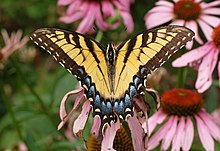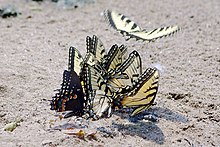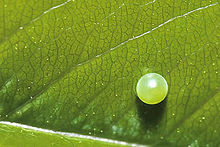
Hi Everybody!!
Do icy fingers still grip you? A friendly reminder that in a couple of weeks, spring will be in full glory. Butterflies will be pollinating the early blooming peach trees as new life begins to pop out everywhere. I have shared info from Wikipedia on the Tiger Swallowtail Butterfly and the lovely peach. As we understand more about the pollination process and feeding the world, we discover how important insects and birds are for the survival of humans. Please open the door for others to learn something new everyday. We are all important and have something to contribute to the global society. Enjoy!


https://en.wikipedia.org/wiki/Peach
| Peach Prunus persica | |
|---|---|
 | |
| Autumn Red Peaches, cross section | |
| Scientific classification | |
| Kingdom: | Plantae |
| (unranked): | Angiosperms |
| (unranked): | Eudicots |
| (unranked): | Rosids |
| Order: | Rosales |
| Family: | Rosaceae |
| Genus: | Prunus |
| Subgenus: | Amygdalus |
| Species: | P. persica |
The peach (Prunus persica) is a deciduous tree, native to North-West China, in the region between the Tarim basin and the north slopes of the Kunlun Shan mountains, where it was first domesticated and cultivated. [2] It bears an edible juicy fruit also called a peach. The species name persica refers to its widespread cultivation in Persia, whence it was transplanted to Europe. It belongs to the genus Prunus which includes the cherry andplum, in the family Rosaceae. The peach is classified with the almond in the subgenusAmygdalus, distinguished from the other subgenera by the corrugated seed shell.
Peaches and nectarines are the same species, even though they are regarded commercially as different fruits. In contrast to peach whose fruits present the characteristic fuzz on the skin nectarines are characterized by the absence of fruit skin trichomes (fuzz-less fruit); genetic studies suggest nectarines are produced due to a recessive allele, whereas peaches are produced from a dominant allele for fuzzy skin.[3]
China is the world's largest producer of peaches and nectarines.

File:Illustration Prunus persica0.jpg
From Wikipedia, the free encyclopedia
Prunus persica grows to 4–10 m (13–33 ft) tall and 6 in. in diameter. The leaves arelanceolate, 7–16 cm (2.8–6.3 in) long, 2–3 cm (0.79–1.18 in) broad, pinnately veined. Theflowers are produced in early spring before the leaves; they are solitary or paired, 2.5–3 cm diameter, pink, with five petals. The fruit has yellow or whitish flesh, a delicate aroma, and a skin that is either velvety (peaches) or smooth (nectarines) in differentcultivars. The flesh is very delicate and easily bruised in some cultivars, but is fairly firm in some commercial varieties, especially when green. The single, large seed is red-brown, oval shaped, approximately 1.3–2 cm long, and is surrounded by a wood-like husk. Peaches, along with cherries, plums and apricots, are stone fruits (drupes). There are various heirloom varieties, including the Indian peach, which arrives in the latter part of the summer.[4]
Cultivated peaches are divided into clingstones and freestones, depending on whether the flesh sticks to the stone or not; both can have either white or yellow flesh. Peaches with white flesh typically are very sweet with little acidity, while yellow-fleshed peaches typically have an acidic tang coupled with sweetness, though this also varies greatly. Both colours often have some red on their skin. Low-acid white-fleshed peaches are the most popular kinds in China, Japan, and neighbouring Asian countries, while Europeans and North Americans have historically favoured the acidic, yellow-fleshed kinds.

https://en.wikipedia.org/wiki/Papilio_glaucus
Papilio glaucus
From Wikipedia, the free encyclopedia
The Eastern tiger swallowtail (Papilio glaucus) is a species of swallowtail butterfly native to North America. It is one of the most familiar butterflies in the eastern United States,[3] where it is common in many different habitats. It flies from spring to fall, during which it produces two to three broods. Adults feed on the nectar of many species of flowers, mostly from those of the Apocynaceae, Asteraceae, and Fabaceae families. P. glaucus has a wingspan measuring 7.9 to 14 cm (3.1 to 5.5 in). The male is yellow with four black "tiger stripes" on each fore wing. Females may be either yellow or black, making them dimorphic. The yellow morph is similar to the male, but with a conspicuous band of blue spots along the hindwind, while the dark morph is almost completely black.
The green eggs are laid singly on plants of the Magnoliaceae and Rosaceae families. Young caterpillars are brown and white; older ones are green with two black, yellow, and blue eyespots on the thorax. The caterpillar will turn brown prior to pupating. It will reach a length of 5.5 centimetres (2.2 in). The chrysalis varies from a whitish color to dark brown.Hibernation occurs in this stage in locations with cold winter months.
| Eastern tiger swallowtail | |
|---|---|
 | |
| Male | |
 | |
| Female | |
| Conservation status | |
 Secure (NatureServe)[1] | |
| Scientific classification | |
| Kingdom: | Animalia |
| Phylum: | Arthropoda |
| Class: | Insecta |
| Order: | Lepidoptera |
| Family: | Papilionidae |
| Genus: | Papilio |
| Species: | P. glaucus |
| Binomial name | |
| Papilio glaucus Linnaeus, 1758 | |
 | |
| Synonyms | |
| |
Description[edit]
The wingspan ranges from 7.9 to 14 cm (3.1 to 5.5 in)[4] with females being the larger sex. Southern individuals are larger than northern ones.[5] Males are yellow with four black "tiger stripes" on each fore wing. The outer edge of the fore wing is black with a row of yellow spots. The veins are marked with black. The postmedian area of the hind wing is black with yellow spots along the margin. The inner margin of the hind wing has small red and blue spots. The ventral fore wing margin has a yellow bar that is broken into spots. This broken bar is present in both sexes, and is used to distinguish P. glaucus from its close relatives.[6]
Females are dimorphic. The yellow morph differs from the male in having a blue postmedian area on the dorsal hind wing. In the dark morph, the areas that are normally yellow are replaced with dark gray or black. The bluish postmedian area on the ventral hind wing has one row of orange spots.[7] A shadow of the "tiger stripes" can be seen on the underside of some dark females.[6]
P. glaucus is one of a few species of papilionids known to produce gynandromorphs. Most bilateral gynandromorphs are hybrids of P. glaucus and P. canadensis that are found along hybrid zones. Color mosaics are found in the central part of the species range.[8]
Distribution and habitat[edit]
P. glaucus is found in the eastern United States from southern Vermont to Florida west to eastern Texas and the Great Plains.[3] It is common throughout its range,[7] although is rarer in southern Florida and absent from the Florida Keys.[3] In 1932, a single specimen was collected in County Wicklow, Ireland. It is believed to have been an accidental introduction from North America.[13] P. glaucus can be found almost anywhere deciduous forests occur. Common habitats include woodlands, fields, rivers, creeks, roadsides, and gardens. It will stray into urban parks and city yards.[4][14][15] Because it has adapted to many different habitats and host plants, P. glaucus is a generalist, and is not considered threatened.[3][9]
Adults are seen from spring to fall, although the exact date varies depending on the location. In the south, they are seen from February to November; in the north, they are seen from May to September.[3][4][14] P. glaucus produces two broods in the north and three in the south. The first broods yield the smallest adults.[3]
The Eastern tiger swallowtail is the state butterfly of Alabama, Delaware, Georgia, North Carolina, and South Carolina,[16] and is thestate insect of Virginia.[17]
Behavior[edit]
Eastern tiger swallowtails are diurnal, and are usually solitary. Adults are known to fly high above the ground, usually seen above the tree canopy.[9][18] Males seek females by patrolling habitats containing the larval host plants. During courtship, the male and female fly about each other prior to landing and mating. The male releases perfume-likepheromones during courtship to entice the female into mating.[3][19]
Adults use a wide range of food sources, most preferring to nectar on sturdy plants with red or pink flowers.[3][5] Many members of the families Apocynaceae, Asteraceae, andFabaceae are used as common nectar sources.[14][15] Males participate in a behavior called puddling, in which they congregate on mud, damp gravel, or puddles. They extract sodium ions and amino acids from these sources which aid in reproduction.[14][20] Males that puddle are typically fresh, and puddle only for their first couple of days. Females will occasionally puddle, but do not form congregations.[20] Adults have also been seen feeding on dung, carrion, and urine.[14]
Life cycle[edit]
Egg[edit]
Females lay their eggs singly on the host plant leaves,[19] preferring to oviposit on host plants near nectar sources.[21] The egg is round and green, later turning yellowish-green with reddish dots.[19] The size of the egg is large for a butterfly, being 0.8 millimeters (0.03 in) in height and 1.2 millimeters (0.05 in) in width.[22] It takes between 4 to 10 days to hatch.[23]
Caterpillar[edit]
The caterpillar eats the leaves of the host plant. It will rest on a silk pad on a leaf, with the edges of the leaf folded over itself and held together with silk.[19][24][25] The first threeinstars are brown. A large white spot, known as a saddle, is found on the abdomen. Aftermolting to the fourth instar, the caterpillar becomes green. The swollen thorax has two black, yellow, and blue eyespots. These eyespots are much smaller than those of the similar-looking Spicebush Swallowtail caterpillar. A yellow and black transverse stripe is present between the first and second abdominal segments. It is concealed between the folds of the segments when the caterpillar is at rest.[19][24] The abdomen is spotted transversely with light blue. Before pupating, the caterpillar will turn dark brown. It will reach a length of 5.5 centimetres (2.2 in). The caterpillar of P. glaucus is impossible to distinguish from the caterpillars of P. canadensis and P. appalachiensis.[19][24]
Chrysalis[edit]
The chrysalis measures 3.2 centimetres (1.3 in).[22] It hangs from a surface by a silk girdle around the thorax and a silk pad at the base.[19] The chrysalis varies in color, ranging from off white to dark brown. It is often spotted with green and dark brown. Ligter-colored chrysalids often have a dark lateral stripe along each side of the body. Two horn-like projections are present on the head; one is found the thorax. P. glaucus chrysalids can be found in a variety of places, but are commonly found on tree trunks, fence posts, and in ground litter.[19] It hibernates in locations with cold winters.[3]
- Egg - It takes 3–5 days for eggs to hatch.
- Larva - The caterpillar has five instars.
- Pupa - The chrysalis stage lasts 9–11 days, or over winter hibernation.
- Adult – Northern areas have 1-2 generations; southern areas may have three.






link to photostudy in G+Albums:
https://plus.google.com/u/0/photos/117645114459863049265/albums/5674238653953219681


...this is brendasue signing off from Rainbow Creek. See You next time!

O+O







No comments:
Post a Comment
Hi Everybody! Please say hello and follow so I know you are here! Due to the inconsideration of people trying to put commercials on my blog comment area, I have restricted use of anonymous posts. Sorry that some hurt all.
My public email is katescabin@gmail.com No spammers or trolls